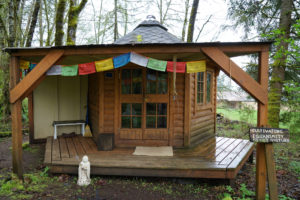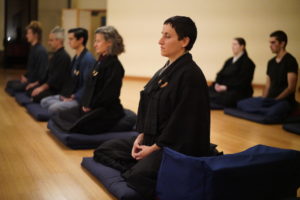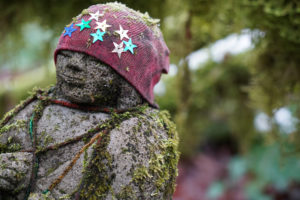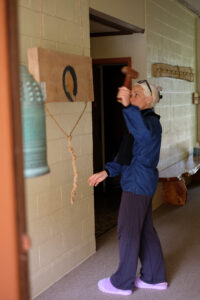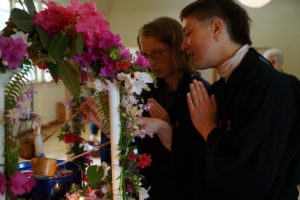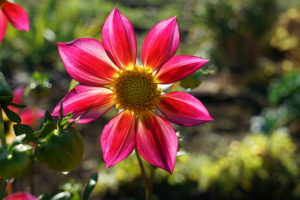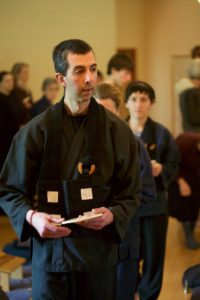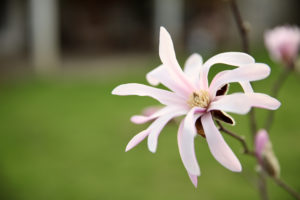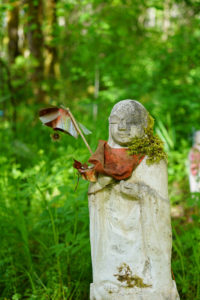Shrine of Vows
A vow is a promise to your future self. It is a contract with yourself. A vow is an aspiration to give life to a spiritual path, a project, a relationship or anything that comes from the core of your being. It is part of your life’s purpose. A vow serves as a channel for your life’s energy, so it is not scattered or frittered away.
To give expression to a vow is to make visible what is invisible in your heart. Formulating a vow requires that you reflect deeply about what is most important to you. It might be helpful to write out or talk about your aspirations for your life. Then distill the vow down to a few sentences or even a few words.
Next you make your vow visible. There are many creative ways to do this. You can write them, carve them, paint them, or sculpt them, using rocks, wood, paper or clay.
The Shrine of Vows is a place to offer your vows, to make them a visible testament of your intentions. It is a place where you can join with others, where you can be inspired by others’ vows. People have made vows of marriage, to knowing God, to become enlightened, to support their children, to cultivate peace, etc.
You are welcome to come to the monastery and place the token of your vow, or you can mail it to us and we will place it for you.
The monastery is located 80 miles northwest of Portland, Oregon on twenty forested acres overlooking the Columbia River flood plain. The monastery includes a spacious meditation hall, guest and resident dormitories, dining hall, and a large organic vegetable garden. Within the forest is Great Vow’s famous Jizo Garden, a memorial garden for people who have died, and the newly dedicated Shrine of Vows, a place where people leave tokens of their deep aspirations
History of the Shrine of Vows
Under a rainy January sky, Great Vow Zen Monastery dedicated an outdoor area of the monastery called the Shrine of Vows. This is a place where people can go to formally set a life intention, leaving a physical marker of their aspiration, such as a painted stone or ceramic tile.
Great Vow has always been “permeable,” meaning that it is open to visitors; long-term residents as well as short-term guests who come for retreats and workshops. Many come to visit its forested Jizo Garden where people can memorialize those who have died, especially children.
Great Vow Zen Monastery gets its name from Jizo, also known as Chenrezig, and Dizang Bodhisattva’s “Great Vow” to be present with, and be of benefit to, all suffering beings in all realms, and to continuously benefit others until “the hells are empty.”
Every January, Great Vow holds a week-long silent retreat (sesshin) called Life Vows which follows a modified sesshin schedule. In this retreat, participants take a little time out of Noble Silence each day to discern and discover their own life vows with the support of a small group. What is important in our life? And are we moving in a direction that reflects our vows?
Hogen Bays, Roshi, co-abbot of Great Vow, was inspired to create the Shrine of Vows after a ZCO pilgrimage to Buddhist temples in China. At many temples and other places you find hundreds of locks brought by people to “lock in” a vow or promise. The locks symbolize commitment to raise a child, end addictive behavior, or a private promise. Many locks have the names of couples who memorialize their commitment to one another.
Hogen wanted to create a similar place in the United States where anyone, Buddhist or not, could come and make a physical expressions of their aspirations.
Short-term vows:
to complete school; complete training or apprenticeship; embark on a journey or complete something.
Family or community vows:
promising to care for a parent for as long as we are able; vowing to raise and care for a child; promising to help people in abusive situations; vowing to care for the Earth.
Ethical vows:
to uphold the Buddhist precepts or specific precepts; to speak kind words even to difficult people; to resolve unwholesome actions and live with integrity; to make amends to beings we may have harmed.
The Shrine of Vows is open to everyone who wants to participate by leaving a token of their own deep intentions. For more details contact Great Vow Zen Monastery by email or call 503-728-0654.
Vows
Seeing all the many vows from others inspires us to discern and share our own vows.
What is a Vow?
Great Vow Zen Monastery’s founder Taizan Maezumi, Roshi was once asked about what happens when we die. He replied that while the physical body may die, it is our vows that live on after death.

